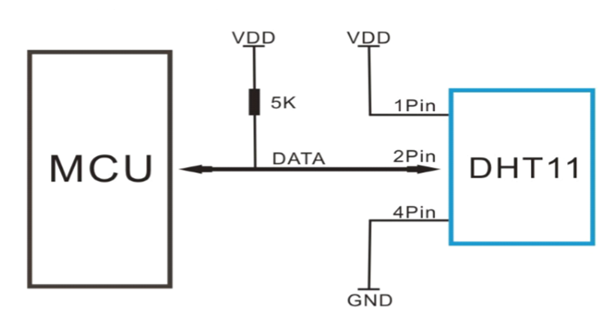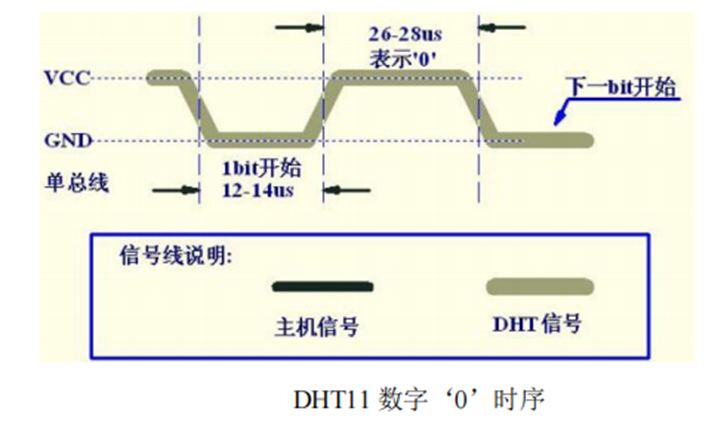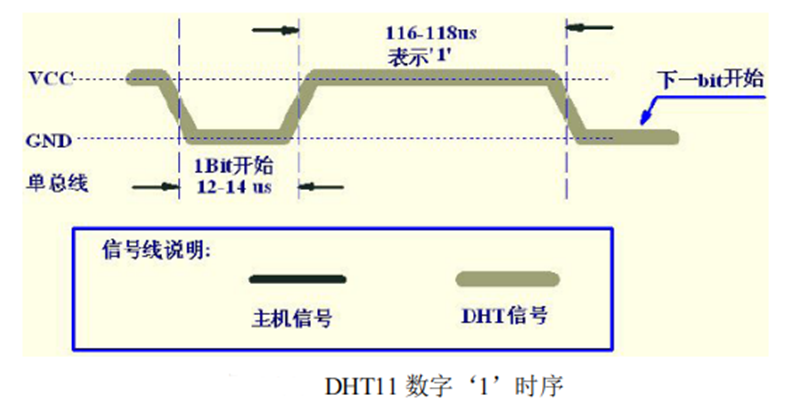传感器介绍
产品详细介绍
DHT11数字温湿度传感器是一款含有已校准数字信号输出的温湿度复合传感器,它应用专用的数字模块采集技术和温湿度传感技术,确保产品具有极高的可靠性和卓越的长期稳定性。传感器包括一个电阻式感湿元件和一个NTC测温元件,并与一个高性能8位单片机相连接。因此该产品具有品质卓越、超快响应、抗干扰能力强、性价比极高等优点。每个DHT11传感器都在极为精确的湿度校验室中进行校准。校准系数以程序的形式存在OTP内存中,传感器内部在检测信号的处理过程中要调用这些校准系数。单线制串行接口,使系统集成变得简易快捷。超小的体积、极低的功耗,使其成为该类应用中,在苛刻应用场合的最佳选择。产品为4针单排引脚封装,连接方便。
典型应用电路

传感器协议
单总线(OneWire)协议介绍
1-wire 单总线是 Maxim 全资子公司 Dallas 的一项专有技术与目前多数标准串行数据通信方式,如 SPI/I2C/MICROWIRE不同,它采用单根信号线,既传输时钟又传输数据,而且数据传输是双向的。它具有节省 I/O口线资源、结构简单、成本低廉、便于总线扩展和维护等诸多优点。
协议图示



代码分析
裸机代码
#include <ioCC2530.h>
#define uint unsigned int
#define uchar unsigned char
#define wenshi P0_6
//温湿度定义
uchar ucharFLAG,uchartemp;
uchar shidu_shi,shidu_ge,wendu_shi,wendu_ge=4;
uchar ucharT_data_H,ucharT_data_L,ucharRH_data_H,ucharRH_data_L,ucharcheckdata;
uchar ucharT_data_H_temp,ucharT_data_L_temp,ucharRH_data_H_temp,ucharRH_data_L_temp,ucharcheckdata_temp;
uchar ucharcomdata;
uchar temp[2]={0,0};
uchar temp1[5]="temp=";
uchar humidity[2]={0,0};
uchar humidity1[9]="humidity=";
/****************************
延时函数
*****************************/
void Delay_us() //1 us延时
{
asm("nop");
asm("nop");
asm("nop");
asm("nop");
asm("nop");
asm("nop");
asm("nop");
asm("nop");
asm("nop");
}
void Delay_10us() //10 us延时
{
Delay_us();
Delay_us();
Delay_us();
Delay_us();
Delay_us();
Delay_us();
Delay_us();
Delay_us();
Delay_us();
Delay_us();
}
void Delay_ms(uint Time)//n ms延时
{
unsigned char i;
while(Time--)
{
for(i=0;i<100;i++)
Delay_10us();
}
}
/***********************
温湿度传感
***********************/
void COM(void) // 温湿写入
{
uchar i;
for(i=0;i<8;i++) /// for 循环 8 次 每次读 一个位
{
ucharFLAG=2;
while((!wenshi)&&ucharFLAG++); //等DHT11 拉高
Delay_10us();
Delay_10us();
Delay_10us(); /// 30 us 之后
uchartemp=0;
if(wenshi)uchartemp=1; //如果还是 高 得 bit = 1
ucharFLAG=2; // 否则 bit = 0
while((wenshi)&&ucharFLAG++); // 等待拉低
if(ucharFLAG==1)break;/// 超时吗?? 不太懂
ucharcomdata<<=1; // 左移一位
ucharcomdata|=uchartemp; // 把读取到的赋值
}
}
void DHT11(void) //温湿传感启动
{
wenshi=0; // 先将 DATA数据线接口拉低
Delay_ms(19); // 延迟大于18 毫秒 复位
wenshi=1; /// 拉高 DATA 数据线
P0DIR &= ~0x40; // 将 DATA 接口 从 输出 设置为输入
Delay_10us();
Delay_10us();
Delay_10us();
Delay_10us(); /// 延时 40 us 拉低了40 us
if(!wenshi) // 此时 DHT11 应该 拉低DATA数据线
{
ucharFLAG=2;
while((!wenshi)&&ucharFLAG++); // 等待拉高 并设置超时
ucharFLAG=2;
while((wenshi)&&ucharFLAG++); // 拉高完成 接下来将会开始传输数据
COM(); // 调用读取函数
ucharRH_data_H_temp=ucharcomdata; //读取出湿度高8
COM();
ucharRH_data_L_temp=ucharcomdata; // 读取出湿度底8
COM();
ucharT_data_H_temp=ucharcomdata; // 读取出温度高8
COM();
ucharT_data_L_temp=ucharcomdata; // 读取出温度低8
COM();
ucharcheckdata_temp=ucharcomdata; // 数据校验码
wenshi=1; //// 拉高 DAta
uchartemp=(ucharT_data_H_temp+ucharT_data_L_temp+ucharRH_data_H_temp+ucharRH_data_L_temp);
if(uchartemp==ucharcheckdata_temp) // 校验数据
{
ucharRH_data_H=ucharRH_data_H_temp;
ucharRH_data_L=ucharRH_data_L_temp;
ucharT_data_H=ucharT_data_H_temp;
ucharT_data_L=ucharT_data_L_temp;
ucharcheckdata=ucharcheckdata_temp;
}
wendu_shi=ucharT_data_H/10;
wendu_ge=ucharT_data_H%10;
shidu_shi=ucharRH_data_H/10;
shidu_ge=ucharRH_data_H%10;
}
else //没用成功读取,返回0
{
wendu_shi=0;
wendu_ge=0;
shidu_shi=0;
shidu_ge=0;
}
}
ZStack代码
DHT11驱动代码 分析 同裸机代码
/**************************************************************************************************
Filename: SampleApp.c
Revised: $Date: 2009-03-18 15:56:27 -0700 (Wed, 18 Mar 2009) $
Revision: $Revision: 19453 $
Description: Sample Application (no Profile).
Copyright 2007 Texas Instruments Incorporated. All rights reserved.
IMPORTANT: Your use of this Software is limited to those specific rights
granted under the terms of a software license agreement between the user
who downloaded the software, his/her employer (which must be your employer)
and Texas Instruments Incorporated (the "License"). You may not use this
Software unless you agree to abide by the terms of the License. The License
limits your use, and you acknowledge, that the Software may not be modified,
copied or distributed unless embedded on a Texas Instruments microcontroller
or used solely and exclusively in conjunction with a Texas Instruments radio
frequency transceiver, which is integrated into your product. Other than for
the foregoing purpose, you may not use, reproduce, copy, prepare derivative
works of, modify, distribute, perform, display or sell this Software and/or
its documentation for any purpose.
YOU FURTHER ACKNOWLEDGE AND AGREE THAT THE SOFTWARE AND DOCUMENTATION ARE
PROVIDED 揂S IS?WITHOUT WARRANTY OF ANY KIND, EITHER EXPRESS OR IMPLIED,
INCLUDING WITHOUT LIMITATION, ANY WARRANTY OF MERCHANTABILITY, TITLE,
NON-INFRINGEMENT AND FITNESS FOR A PARTICULAR PURPOSE. IN NO EVENT SHALL
TEXAS INSTRUMENTS OR ITS LICENSORS BE LIABLE OR OBLIGATED UNDER CONTRACT,
NEGLIGENCE, STRICT LIABILITY, CONTRIBUTION, BREACH OF WARRANTY, OR OTHER
LEGAL EQUITABLE THEORY ANY DIRECT OR INDIRECT DAMAGES OR EXPENSES
INCLUDING BUT NOT LIMITED TO ANY INCIDENTAL, SPECIAL, INDIRECT, PUNITIVE
OR CONSEQUENTIAL DAMAGES, LOST PROFITS OR LOST DATA, COST OF PROCUREMENT
OF SUBSTITUTE GOODS, TECHNOLOGY, SERVICES, OR ANY CLAIMS BY THIRD PARTIES
(INCLUDING BUT NOT LIMITED TO ANY DEFENSE THEREOF), OR OTHER SIMILAR COSTS.
Should you have any questions regarding your right to use this Software,
contact Texas Instruments Incorporated at www.TI.com.
**************************************************************************************************/
/*********************************************************************
This application isn't intended to do anything useful, it is
intended to be a simple example of an application's structure.
This application sends it's messages either as broadcast or
broadcast filtered group messages. The other (more normal)
message addressing is unicast. Most of the other sample
applications are written to support the unicast message model.
Key control:
SW1: Sends a flash command to all devices in Group 1.
SW2: Adds/Removes (toggles) this device in and out
of Group 1. This will enable and disable the
reception of the flash command.
*********************************************************************/
/*********************************************************************
* INCLUDES
*/
#include "OSAL.h"
#include "ZGlobals.h"
#include "AF.h"
#include "aps_groups.h"
#include "ZDApp.h"
#include "SampleApp.h"
#include "SampleAppHw.h"
#include "OnBoard.h"
/* HAL */
#include "hal_lcd.h"
#include "hal_led.h"
#include "hal_key.h"
#include "MT_UART.h" //此处用于串口
#include "DHT11.h" //温湿度专用
/*********************************************************************
* MACROS
*/
/*********************************************************************
* CONSTANTS
*/
/*********************************************************************
* TYPEDEFS
*/
/*********************************************************************
* GLOBAL VARIABLES
*/
// This list should be filled with Application specific Cluster IDs.
const cId_t SampleApp_ClusterList[SAMPLEAPP_MAX_CLUSTERS] =
{
SAMPLEAPP_PERIODIC_CLUSTERID,
SAMPLEAPP_FLASH_CLUSTERID
};
const SimpleDescriptionFormat_t SampleApp_SimpleDesc =
{
SAMPLEAPP_ENDPOINT, // int Endpoint;
SAMPLEAPP_PROFID, // uint16 AppProfId[2];
SAMPLEAPP_DEVICEID, // uint16 AppDeviceId[2];
SAMPLEAPP_DEVICE_VERSION, // int AppDevVer:4;
SAMPLEAPP_FLAGS, // int AppFlags:4;
SAMPLEAPP_MAX_CLUSTERS, // uint8 AppNumInClusters;
(cId_t *)SampleApp_ClusterList, // uint8 *pAppInClusterList;
SAMPLEAPP_MAX_CLUSTERS, // uint8 AppNumInClusters;
(cId_t *)SampleApp_ClusterList // uint8 *pAppInClusterList;
};
// This is the Endpoint/Interface description. It is defined here, but
// filled-in in SampleApp_Init(). Another way to go would be to fill
// in the structure here and make it a "const" (in code space). The
// way it's defined in this sample app it is define in RAM.
endPointDesc_t SampleApp_epDesc;
/*********************************************************************
* EXTERNAL VARIABLES
*/
/*********************************************************************
* EXTERNAL FUNCTIONS
*/
/*********************************************************************
* LOCAL VARIABLES
*/
uint8 SampleApp_TaskID; // Task ID for internal task/event processing
// This variable will be received when
// SampleApp_Init() is called.
devStates_t SampleApp_NwkState;
uint8 SampleApp_TransID; // This is the unique message ID (counter)
afAddrType_t SampleApp_Periodic_DstAddr;
afAddrType_t SampleApp_Flash_DstAddr;
afAddrType_t Point_To_Point_DstAddr;//网蜂点对点通信定义
aps_Group_t SampleApp_Group;
uint8 SampleAppPeriodicCounter = 0;
uint8 SampleAppFlashCounter = 0;
/*********************************************************************
* LOCAL FUNCTIONS
*/
void SampleApp_HandleKeys( uint8 shift, uint8 keys );
void SampleApp_MessageMSGCB( afIncomingMSGPacket_t *pckt );
void SampleApp_SendPeriodicMessage( void );
void SampleApp_SendFlashMessage( uint16 flashTime );
void SampleApp_SendPointToPointMessage(void );
/*********************************************************************
* NETWORK LAYER CALLBACKS
*/
/*********************************************************************
* PUBLIC FUNCTIONS
*/
/*********************************************************************
* @fn SampleApp_Init
*
* @brief Initialization function for the Generic App Task.
* This is called during initialization and should contain
* any application specific initialization (ie. hardware
* initialization/setup, table initialization, power up
* notificaiton ... ).
*
* @param task_id - the ID assigned by OSAL. This ID should be
* used to send messages and set timers.
*
* @return none
*/
void SampleApp_Init( uint8 task_id )
{
SampleApp_TaskID = task_id;
SampleApp_NwkState = DEV_INIT;
SampleApp_TransID = 0;
MT_UartInit();//串口初始化
MT_UartRegisterTaskID(task_id);//登记任务号
HalUARTWrite(0,"Hello World\n",12); //(串口0,'字符',字符个数。)
//温湿度传感器初始化 P0.6
P0SEL &= 0xbf;
// Device hardware initialization can be added here or in main() (Zmain.c).
// If the hardware is application specific - add it here.
// If the hardware is other parts of the device add it in main().
#if defined ( BUILD_ALL_DEVICES )
// The "Demo" target is setup to have BUILD_ALL_DEVICES and HOLD_AUTO_START
// We are looking at a jumper (defined in SampleAppHw.c) to be jumpered
// together - if they are - we will start up a coordinator. Otherwise,
// the device will start as a router.
if ( readCoordinatorJumper() )
zgDeviceLogicalType = ZG_DEVICETYPE_COORDINATOR;
else
zgDeviceLogicalType = ZG_DEVICETYPE_ROUTER;
#endif // BUILD_ALL_DEVICES
#if defined ( HOLD_AUTO_START )
// HOLD_AUTO_START is a compile option that will surpress ZDApp
// from starting the device and wait for the application to
// start the device.
ZDOInitDevice(0);
#endif
// Setup for the periodic message's destination address
// Broadcast to everyone
SampleApp_Periodic_DstAddr.addrMode = (afAddrMode_t)AddrBroadcast;
SampleApp_Periodic_DstAddr.endPoint = SAMPLEAPP_ENDPOINT;
SampleApp_Periodic_DstAddr.addr.shortAddr = 0xFFFF;
// Setup for the flash command's destination address - Group 1
SampleApp_Flash_DstAddr.addrMode = (afAddrMode_t)afAddrGroup;
SampleApp_Flash_DstAddr.endPoint = SAMPLEAPP_ENDPOINT;
SampleApp_Flash_DstAddr.addr.shortAddr = SAMPLEAPP_FLASH_GROUP;
// 网蜂点对点通讯定义
Point_To_Point_DstAddr.addrMode = (afAddrMode_t)Addr16Bit;//点播
Point_To_Point_DstAddr.endPoint = SAMPLEAPP_ENDPOINT;
Point_To_Point_DstAddr.addr.shortAddr = 0x0000; //发给协调器
// Fill out the endpoint description.
SampleApp_epDesc.endPoint = SAMPLEAPP_ENDPOINT;
SampleApp_epDesc.task_id = &SampleApp_TaskID;
SampleApp_epDesc.simpleDesc
= (SimpleDescriptionFormat_t *)&SampleApp_SimpleDesc;
SampleApp_epDesc.latencyReq = noLatencyReqs;
// Register the endpoint description with the AF
afRegister( &SampleApp_epDesc );
// Register for all key events - This app will handle all key events
RegisterForKeys( SampleApp_TaskID );
// By default, all devices start out in Group 1
SampleApp_Group.ID = 0x0001;
osal_memcpy( SampleApp_Group.name, "Group 1", 7 );
aps_AddGroup( SAMPLEAPP_ENDPOINT, &SampleApp_Group );
#if defined ( LCD_SUPPORTED )
HalLcdWriteString( "SampleApp", HAL_LCD_LINE_1 );
#endif
}
/*********************************************************************
* @fn SampleApp_ProcessEvent
*
* @brief Generic Application Task event processor. This function
* is called to process all events for the task. Events
* include timers, messages and any other user defined events.
*
* @param task_id - The OSAL assigned task ID.
* @param events - events to process. This is a bit map and can
* contain more than one event.
*
* @return none
*/
uint16 SampleApp_ProcessEvent( uint8 task_id, uint16 events )
{
afIncomingMSGPacket_t *MSGpkt;
(void)task_id; // Intentionally unreferenced parameter
if ( events & SYS_EVENT_MSG )
{
MSGpkt = (afIncomingMSGPacket_t *)osal_msg_receive( SampleApp_TaskID );
while ( MSGpkt )
{
switch ( MSGpkt->hdr.event )
{
// Received when a key is pressed
case KEY_CHANGE:
SampleApp_HandleKeys( ((keyChange_t *)MSGpkt)->state, ((keyChange_t *)MSGpkt)->keys );
break;
// Received when a messages is received (OTA) for this endpoint
case AF_INCOMING_MSG_CMD:
SampleApp_MessageMSGCB( MSGpkt );
break;
// Received whenever the device changes state in the network
case ZDO_STATE_CHANGE:
SampleApp_NwkState = (devStates_t)(MSGpkt->hdr.status);
if ( //(SampleApp_NwkState == DEV_ZB_COORD)|| //协调器不给自己点播
(SampleApp_NwkState == DEV_ROUTER)
|| (SampleApp_NwkState == DEV_END_DEVICE) )
{
// Start sending the periodic message in a regular interval.
osal_start_timerEx( SampleApp_TaskID,
SAMPLEAPP_SEND_PERIODIC_MSG_EVT,
SAMPLEAPP_SEND_PERIODIC_MSG_TIMEOUT );
}
else
{
// Device is no longer in the network
}
break;
default:
break;
}
// Release the memory
osal_msg_deallocate( (uint8 *)MSGpkt );
// Next - if one is available
MSGpkt = (afIncomingMSGPacket_t *)osal_msg_receive( SampleApp_TaskID );
}
// return unprocessed events
return (events ^ SYS_EVENT_MSG);
}
// Send a message out - This event is generated by a timer
// (setup in SampleApp_Init()).
if ( events & SAMPLEAPP_SEND_PERIODIC_MSG_EVT )
{
uint8 T[8]; //温度+提示符
DHT11(); //温度检测 调用DHT11 库 获取温度
T[0]=wendu_shi+48; // 温
T[1]=wendu_ge+48; // 度
T[2]=' '; // 格
T[3]=shidu_shi+48; // 式
T[4]=shidu_ge+48; // 化
T[5]=' ';
T[6]=' ';
T[7]=' ';
SampleApp_SendPointToPointMessage();// 发送 温度数据到协调器
// 启动 一个定时的时间 回调 时间是随机的 运行自己
osal_start_timerEx( SampleApp_TaskID, SAMPLEAPP_SEND_PERIODIC_MSG_EVT,
(SAMPLEAPP_SEND_PERIODIC_MSG_TIMEOUT + (osal_rand() & 0x00FF)) );
return (events ^ SAMPLEAPP_SEND_PERIODIC_MSG_EVT);
}
// Discard unknown events
return 0;
}
/*********************************************************************
* Event Generation Functions
*/
/*********************************************************************
* @fn SampleApp_HandleKeys
*
* @brief Handles all key events for this device.
*
* @param shift - true if in shift/alt.
* @param keys - bit field for key events. Valid entries:
* HAL_KEY_SW_2
* HAL_KEY_SW_1
*
* @return none
*/
void SampleApp_HandleKeys( uint8 shift, uint8 keys )
{
(void)shift; // Intentionally unreferenced parameter
if ( keys & HAL_KEY_SW_1 )
{
/* This key sends the Flash Command is sent to Group 1.
* This device will not receive the Flash Command from this
* device (even if it belongs to group 1).
*/
SampleApp_SendFlashMessage( SAMPLEAPP_FLASH_DURATION );
}
if ( keys & HAL_KEY_SW_2 )
{
/* The Flashr Command is sent to Group 1.
* This key toggles this device in and out of group 1.
* If this device doesn't belong to group 1, this application
* will not receive the Flash command sent to group 1.
*/
aps_Group_t *grp;
grp = aps_FindGroup( SAMPLEAPP_ENDPOINT, SAMPLEAPP_FLASH_GROUP );
if ( grp )
{
// Remove from the group
aps_RemoveGroup( SAMPLEAPP_ENDPOINT, SAMPLEAPP_FLASH_GROUP );
}
else
{
// Add to the flash group
aps_AddGroup( SAMPLEAPP_ENDPOINT, &SampleApp_Group );
}
}
}
/*********************************************************************
* LOCAL FUNCTIONS
*/
/*********************************************************************
* @fn SampleApp_MessageMSGCB
*
* @brief Data message processor callback. This function processes
* any incoming data - probably from other devices. So, based
* on cluster ID, perform the intended action.
*
* @param none
*
* @return none
*/
void SampleApp_MessageMSGCB( afIncomingMSGPacket_t *pkt )
{
uint16 flashTime;
switch ( pkt->clusterId )
{
case SAMPLEAPP_POINT_TO_POINT_CLUSTERID:
/***********温度打印***************/
HalUARTWrite(0,"Temp is:",8); //提示接收到数据
HalUARTWrite(0,&pkt->cmd.Data[0],2); //温度
HalUARTWrite(0,"\n",1); // 回车换行
/***************湿度打印****************/
HalUARTWrite(0,"Humidity is:",12); //提示接收到数据
HalUARTWrite(0,&pkt->cmd.Data[2],2); //湿度
HalUARTWrite(0,"\n",1); // 回车换行
break;
case SAMPLEAPP_FLASH_CLUSTERID:
flashTime = BUILD_UINT16(pkt->cmd.Data[1], pkt->cmd.Data[2] );
HalLedBlink( HAL_LED_4, 4, 50, (flashTime / 4) );
break;
}
}
/*********************************************************************
* @fn SampleApp_SendPeriodicMessage
*
* @brief Send the periodic message.
*
* @param none
*
* @return none
*/
void SampleApp_SendPeriodicMessage( void )
{
uint8 data[10]={'0','1','2','3','4','5','6','7','8','9'};//自定义数据
if ( AF_DataRequest( &SampleApp_Periodic_DstAddr, &SampleApp_epDesc,
SAMPLEAPP_PERIODIC_CLUSTERID,
10,//字节数
data,//指针头
&SampleApp_TransID,
AF_DISCV_ROUTE,
AF_DEFAULT_RADIUS ) == afStatus_SUCCESS )
{
}
else
{
// Error occurred in request to send.
}
}
/*********************************************************************
* @fn SampleApp_SendFlashMessage
*
* @brief Send the flash message to group 1.
*
* @param flashTime - in milliseconds
*
* @return none
*/
void SampleApp_SendFlashMessage( uint16 flashTime )
{
uint8 buffer[3];
buffer[0] = (uint8)(SampleAppFlashCounter++);
buffer[1] = LO_UINT16( flashTime );
buffer[2] = HI_UINT16( flashTime );
/// 发送 温度数据到 协调器
if ( AF_DataRequest( &SampleApp_Flash_DstAddr, &SampleApp_epDesc,
SAMPLEAPP_FLASH_CLUSTERID,
3,
buffer,
&SampleApp_TransID,
AF_DISCV_ROUTE,
AF_DEFAULT_RADIUS ) == afStatus_SUCCESS )
{
}
else
{
// Error occurred in request to send.
}
}
/*********************************************************************
*********************************************************************/
void SampleApp_SendPointToPointMessage( void )
{
uint8 T_H[4];//温湿度
T_H[0]=wendu_shi+48;
T_H[1]=wendu_ge%10+48;
T_H[2]=shidu_shi+48;
T_H[3]=shidu_ge%10+48;
if ( AF_DataRequest( &Point_To_Point_DstAddr,
&SampleApp_epDesc,
SAMPLEAPP_POINT_TO_POINT_CLUSTERID,
4,
T_H,
&SampleApp_TransID,
AF_DISCV_ROUTE,
AF_DEFAULT_RADIUS ) == afStatus_SUCCESS )
{
}
else
{
// Error occurred in request to send.
}
}